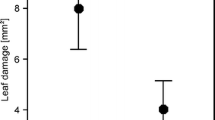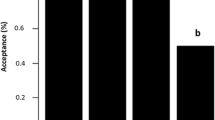Summary
The relative susceptibility to predators of a cryptic generalist caterpillar (Spilosoma congrua: Arctiidae) and a non-cryptic specialist (Junonia coenia: Nymphalidae) using the same hostplant species (Plantago lanceolata) was examined. In a laboratory experiment using predatory stinkbugs (Podisus maculiventris), more Junonia caterpillars than Spilosoma caterpillars were killed (70% vs. 16%). This result was a consequence of the Spilosoma spending some time under cover, moving frequently, feeding on leaves while under or adjacent to them, and spending little time on the leaves. In a field experiment using predatory wasps (Polistes fuscatus), the wasps found 7 times as many of the Junonia as the Spilosoma, and overall 6 times as many Junonia were killed as Spilosoma. Initially, 71% of the Junonia caterpillars encountered by wasps were killed, but by the fourth day of the test, only 22% of the Junonia encountered by wasps were killed. Over three full days of observations, a constant 50% of the Spilosoma caterpillars encountered by the wasps per day were killed. For the Junonia, evasion of predators rested on passive chemical defense. For the Spilosoma, evasion depended on being unapparent, speedy movement between feeding and resting sites and, if found, on fleeing immediately and quickly. These results indicate that Spilosoma caterpillars, by way of cryptic and escape behaviors, can be less susceptible to insect predators than Junonia caterpillars.
Similar content being viewed by others
References
Bernays EA (1988) Host specificity in phytophagous insects: selection pressure from generalist predators. Entomol Exp Appl 49: 131–140
Bernays EA (1989) Host range in phytophagous insects: the potential role of generalist predators. Evol Ecol 3: 299–311
Bernays EA, Cornelius ML (1989) Generalist caterpillar prey are more palatable than specialists for the generalist predator Iridomyrmex humilis. Oecologia 79: 427–430
Bernays EA, Graham M (1988) On the evolution of host specificity in phytophagous arthropods. Ecology 69: 886–892
Bobbitt JM, Segebarth DP (1969) Iridoid glycosides and similar substances. In: Taylor WI, Battersby AR (eds) Cyclopentanoid terpene derivatives. Marcel Dekker, New York, pp 1–145
Bowers MD (1984) Tridoid glycosides and host-plant specificity in larvae of the buckeye butterflies, Junonia coenia (Nymphalidae). J Chem Ecol 10: 1567–1577
Bowers MD (1992) Aposematic caterpillars: Lifestyles of the warningly colored and unpalatable. In: Stamp NE, Casey TM (eds) Caterpillars: ecological and evolutionary constraints on foraging. Chapman and Hall, New York (in press)
Bowers MD, Collinge SK (1992) Sequestration and metabolism of iridoid glycosides by larvae of the buckeye, Junonia coenia (Nymphalidae): the cost of chemical defense. J Chem Ecol (in press)
Bowers MD, Stamp NE (1992) Chemical variation within and between individuals of Plantago lanceolata (Plantaginaceae). J Chem Ecol: in press
Brower LP (1958) Bird predation and foodplant specificity in closely related procryptic insects. Am Nat 92: 183–187
Casey TM (1976) Activity patterns, body temperatures and thermal ecology in two desert caterpillars (Lepidoptera: Sphingidae). Ecology 57: 485–497
Duff R, Bacon J, Mundie C, Farmer V, Russell J, Forrester A (1965) Catalpol and methylcatalpol: naturally occurring glycosides in Plantago and Buddleia species. Biochem J 96: 1–5
Gould WP, Jeanne RL (1984) Polistes wasps (Hymenoptera: Vespidae) as control agents for lepidopteran cabbage pests. Environ Entomol 13: 150–156
Herrebout WM, Kuyten PJ, de Ruiter L (1963) Observations on colour patterns and behaviour of caterpillars feeding on Scots pine. Arch Neerl Zool 15: 315–357
Jeffries MJ, Lawton JH (1984) Enemy free space and the structure of ecological communities. Biol J Linn Soc 23: 269–286
Jones RE, Rienks J, Wilson L, Lokkers C, Churchill T (1987) Temperature, development and survival in monophagous and polyphagous tropical pierid butterflies. Aust J Zool 35: 235–246
Knapp R, Casey TM (1986) Thermal ecology behavior, and growth of gypsy moth and eastern tent caterpillars. Ecology 67: 598–608
Lopez JD Jr, Ridgway RL, Pinnell RE (1976) Comparative efficacy of four insect predators of the bollworm and tobacco budworm. Environ Entomol 5: 1160–1164
Mukerji MK, LeRoux EJ (1965) Laboratory rearing of a Quebec strain of the pentatomid predator, Podisus maculiventris (Say) (Hemiptera: Pentatomidae). Phytoprotection 46: 40–60
Rabb RL (1960) Biological studies of Polistes in North Carolina (Hymenoptera: Vespidae). Ann Entomol Soc Am 53: 111–121
Schultz JC (1983) Habitat selection and foraging tactics of caterpillars in heterogeneous trees. In: Denno RF, McClure MS (eds) Variable plants and herbivores in natural and managed systems. Academic Press, New York, pp 61–90
Scott J (1975) Movement of Precis coenia, a “pseudoterritorial” submigrant (Lepidoptera: Nymphalidae). J Anim Ecol 44: 843–850
Shapiro AM (1974) Butterflies of the Suisun Marsh, California. J Res Lepid 13: 191–206
Sherman PW, Watt WB (1973) The thermal ecology of some Colias butterflies. J Comp Physiol 83: 25–40
Siegel S (1956) Nonparametric statistics for the behavioral sciences. McGraw-Hill, New York
Stamp NE, Bowers MD (1991) Indirect effect on survivorship of caterpillars due to presence of invertebrate predators. Oecologia 88: 325–330
Stamp NE, Bowers MD (1992) Foraging behavior of specialist and generalist caterpillars on plantain (Plantago lanceolata). Ecol Entomol 17: (in press)
Stamp NE, Wilkens RT (1992) On the cryptic side of life: Being unapparent to enemies and the consequences for foraging and growth of caterpillars. In: Stamp NE, Casey TM (eds) Caterpillars: ecological and evolutionary constraints on foraging. Chapman and Hall, New York (in press)
Tietz HM (1972) An index to the described life histories, early stages and hosts of the Macrolepidoptera of the continental United States and Canada, Vol. II. Allyn Museum, Sarasota, FL
Tostowaryk W (1971) Life history and behavior of Podisus modestus (Hemiptera: Pentatomidae) in boreal forest in Quebec. Can Entomol 103: 662–673
Zar JH (1984) Biostatistical analysis, 2nd ed. Prentice-Hall, Englewood Cliffs, NJ
Author information
Authors and Affiliations
Rights and permissions
About this article
Cite this article
Stamp, N.E. Relative susceptibility to predation of two species of caterpillar on plantain. Oecologia 92, 124–129 (1992). https://doi.org/10.1007/BF00317272
Received:
Accepted:
Issue Date:
DOI: https://doi.org/10.1007/BF00317272




